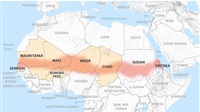Pacific countries plead for inclusion in 'trans-Tasman bubble' as travel restrictions ease

Pacific Island
nations are urging Australia and New Zealand to include them in a planned
travel “bubble”, as flights across the region resume.
Pacific
governments face a delicate balancing act, weighing the devastating economic
impact of border closures and travel restrictions on their tourism-dependent
economies, with the risk of widespread and uncontrollable Covid-19 infections
if the virus is introduced.
The Pacific
region has had very low numbers of Covid-19 infections – just 305 confirmed
cases to date – due to its geographic isolation and the strict enforcement of
border closures.
Fiji and New
Zealand this week declared themselves free of Covid-19, while other Pacific
nations, including Vanuatu, Solomon Islands and Tonga, have successfully kept
the virus from their shores altogether.
But in a part
of the world that is financially dependent on tourism and which imports much of
its food, fuel and other vital supplies, travel lockdowns have hit Pacific
economies especially hard.
Fiji Airways
has laid off 775 employees – more than half its workforce – while in Vanuatu,
70% of tourism workers have lost their jobs. A recent survey of Cook Islands
businesses forecast a 90% drop in revenue from the economic impact of
coronavirus travel restrictions.
Some Pacific
leaders have expressed hope that inclusion in a travel bubble with Australia
and New Zealand, which may open by September, could alleviate some of this
distress.
“A travel bubble that includes Fiji alongside Australia
and New Zealand would do far more good than any aid or assistance … we want to
be in that bubble,” said Aiyaz Sayed-Khaiyum, Fiji’s minister for the economy
at the end of May, after detailing how pandemic travel restrictions could see
government revenues halve next financial year.
“The hard truth is that if this drags on much longer,
we’ll be coming to you for help one way or the other,” said Fletcher Melvin,
the chair of the Cook Islands private sector taskforce, addressing the New
Zealand government. “Our community wants a hand, not a handout – we’d much
rather have New Zealand tourism dollars than its aid money.”
New Zealand
and Australia have been reluctant to consider including Pacific neighbours.
Australia has indicated Pacific labourers might be able to travel to Australia
to work, but two-way travel is not yet currently being considered.
“The last thing we want to do is imperil those
populations,” said Winston Peters, New Zealand’s foreign minister at the end of
March, when the idea was first raised.
Governments
across the Pacific also hold concerns that if the virus were to gain a
significant foothold in the region it could devastate island communities, which
have limited public health infrastructure, and populations with high rates of
comorbidities, such as diabetes.
Secretary-general
of the Pacific Islands Forum, Dame Meg Taylor, told the Asia Society Policy
Institute in May that any reopening would “take time” and that government’s
first priority must be “that people stay healthy”.
“We just
don’t have strong health systems, health services and health infrastructure.”
Travel is
beginning to resume across the Pacific, but so far has largely been limited to
the repatriation of citizens, or travel between communities with existing close
ties.
But flights
from Paris to French Polynesia will resume next month with RNZ reporting that
from 15 July, travellers from Europe, the United States and New Caledonia will
be allowed to enter the country, though they must have a Covid-19 test three
days before departing for the territory and four days after arrival.







